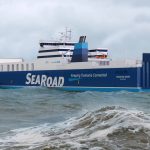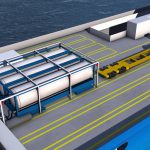The Australian ship-owner and logistics company, SeaRoad, have ordered their first LNG driven roro ferry at Flensburger Schiffbau-Gesellschaft (FSG). The yard is currently in the detailed design phase before the actual steel cutting starts in October 2015.
The new roro ferry for SeaRoad will be sailing on a daily schedule across Bass Strait and with this new[ds_preview] vessel SeaRoad is effectively increasing the current fleet capacity by approx. 50% and will further improve the service quality for their clients. Preceding this was a long projecting phase during which the technical specifics and requirements of the trade between Melbourne and Devonport (Tasmania) had to be analysed and considered before the contract could be signed in 2014.
With its clean air fuel technology (LNG) and the high energy efficiency this RoRo ferry will allow faster transit times and thus longer loading times in port. With the high expertise of Flensburger in the hydrodynamic development of the hull lines this vessel will be able to maintain a more stable schedule even in the harsh conditions of Bass Strait.
The vessel is DNV classed, and although purpose built for the Bass Strait it is at the time fully compliant with the rules and regulations for worldwide operation. The overall principal dimensions are 181m loa, breadth moulded of 26,6m at a design draft of 5,9m. She has a deadweight of 7,980t and a speed of up to 20,5 kts. The deckhouse is designed for a crew of 24 persons and in accordance with the AMSA (Australian flag state requirements). She will be able to carry a broad mix of cargo types ranging from standard road trailers to cassettes with TEUs, DG cargo, project cargo, reefers, cars, and livestock.
Cargo operation
The total lane metres of the vessel are 1,930m, offering space for approximately 125 Australian road trailers and roughly 111 private cars. The cars can be stowed on the tank-top and on an additional mezzanine deck operated by an internal crocodile type ramp configuration. The vessel is connected to the shore facilities in port via two ship-sided stern ramps which are operated individually. The PS stern ramp has a free width of 4,9m and services the weather deck. The SB stern ramp has a width of 10m and allows two way traffic on the ramp while servicing the main cargo hold. The tank top is loaded from the main deck via a 4,1m wide fixed ramp. During sailing the main deck and tank top are separated by watertight ramp covers which are hydraulically operated.
The cargo decks offer a mixture of SAT lashing pots and flush elephant foot type lashing pots allowing for the different cargo mix. Also on main deck swing out fenders are installed on SB side so that the cassettes can easily be block stowed and secured. On weather deck aft/below of the deckhouse a special deck area is designated for the transport of livestock including drainage system for the biological waste. The weather deck forward of the deckhouse is covered. Due to the specific requirements from SeaRoad regarding their cargo loading sequences this covered area is equipped with gas detectors and special drainage and sprinkler systems so that the combined transport of reefer trailers and DG trailers is possible.
Propulsion and fuel concept
The main propulsion system of the ship consists of two dual fuel MaK 8M46 DF main engines, each with a power output of 7,200kW. They operate via two single input/single output reduction gearboxes on to two controllable pitch propellers. For the generation of electrical power two shaft generators of 1,500 kVA are installed. The ship is equipped with two twist flow rudders, designed by Flensburger, which reduce the drag during normal sailing and offer best manoeuvring performance. The vessel requires very good manoeuvring characteristics in port due to restriction on the Tasmanian side and therefore is equipped with two 1,000 kW electrically driven bow thrusters. Due to high cooling requirements of reefer trailers in port SeaRoad required a large auxiliary capacity in addition to the shaft generators. This is provided by two dual fuel MaK 6M34 DF generator sets, each with a power output of 3,100kVA. As primary fuel the main engines as well as the auxiliary generator sets are driven with liquefied natural gas (LNG) and therefore fulfill the strict emissions standards according to IMO III rules.
Zeppelin Power Systems, the official distribution and service partner of Caterpillar for Cat and MaK engines, has provided the planning and engineering of the complete engine set-up. Furthermore, Zeppelin has been responsible since the initial planning and will continue to work closely with Flensburger till the final delivery of the complete engines package, including the commissioning. The engines will be manufactured at the Caterpillar center in Rostock-Warnemünde. Flensburger will receive a customized solution, specially designed to meet their customer’s requirements regarding an environmentally friendly and reliable operation of their vessel.
Furthermore, a flexible tank concept is being employed that has been jointly developed by SeaRoad and FSG. SeaRoad operates LNG-driven trucks in Australia and from there the idea to use normal LNG road trailers as ship’s tanks was developed. This turned out to be major advantage as both costs and space for fixed LNG tanks could be saved. At the same time it provides additional flexibility in port infrastructures where no reliable LNG bunkering can be provided. Since Australia has significant LNG reserves, the fuel is transported by means of road LNG trailers from the nearest LNG terminal directly on board the vessel. This way of »bunkering« is part of the normal loading/unloading process: The LNG trailers are driven onto the aft weather deck and parked in a designated bay. By using a special locking mechanism they become the ship’s LNG tanks. During operation, the LNG is driven out of the connected road trailers via the LNG vaporizer unit in the gas handling room, directly to the dual fuel engines. For a round trip between Melbourne and Devonport three LNG road trailers are needed. While the vessel is sailing a spare set of LNG road trailers will be refilled and waiting in harbour for the next tank exchange.
Due to the pilot status of this LNG driven vessel in Australia, SeaRoad conducted an extensive risk analysis together with DNV to evaluate all possible impacts in port and at sea. In case of unavailability of LNG as primary fuel SeaRoad can switch over to marine diesel as fuel alternative at any time, as all necessary ship’s tanks and fuel systems are installed. Special focus has also been given to the hydrodynamic development of the hull lines in order to provide schedule reliability throughout the year and to reduce the overall fuel consumption. The values have been verified by tank tests before contract signing in addition to extensive manoeuvring simulations in Europe and in Australia.
Raimon Strunck




















